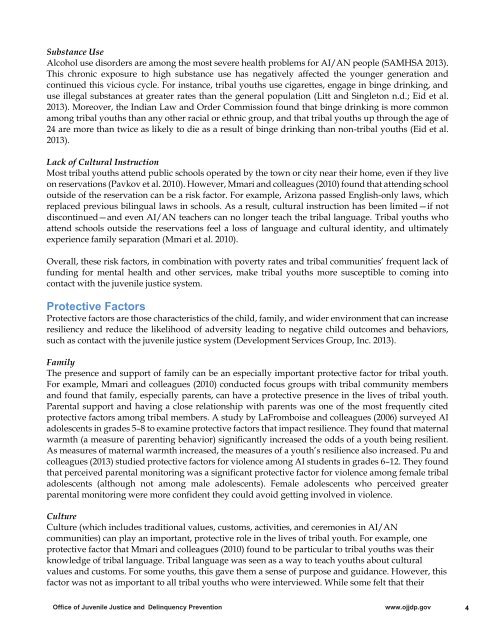Native American Youth In The Juvenile Justice System
Native American Youth In The Juvenile Justice System
Native American Youth In The Juvenile Justice System
Create successful ePaper yourself
Turn your PDF publications into a flip-book with our unique Google optimized e-Paper software.
Substance Use<br />
Alcohol use disorders are among the most severe health problems for AI/AN people (SAMHSA 2013).<br />
This chronic exposure to high substance use has negatively affected the younger generation and<br />
continued this vicious cycle. For instance, tribal youths use cigarettes, engage in binge drinking, and<br />
use illegal substances at greater rates than the general population (Litt and Singleton n.d.; Eid et al.<br />
2013). Moreover, the <strong>In</strong>dian Law and Order Commission found that binge drinking is more common<br />
among tribal youths than any other racial or ethnic group, and that tribal youths up through the age of<br />
24 are more than twice as likely to die as a result of binge drinking than non-tribal youths (Eid et al.<br />
2013).<br />
Lack of Cultural <strong>In</strong>struction<br />
Most tribal youths attend public schools operated by the town or city near their home, even if they live<br />
on reservations (Pavkov et al. 2010). However, Mmari and colleagues (2010) found that attending school<br />
outside of the reservation can be a risk factor. For example, Arizona passed English-only laws, which<br />
replaced previous bilingual laws in schools. As a result, cultural instruction has been limited—if not<br />
discontinued—and even AI/AN teachers can no longer teach the tribal language. Tribal youths who<br />
attend schools outside the reservations feel a loss of language and cultural identity, and ultimately<br />
experience family separation (Mmari et al. 2010).<br />
Overall, these risk factors, in combination with poverty rates and tribal communities’ frequent lack of<br />
funding for mental health and other services, make tribal youths more susceptible to coming into<br />
contact with the juvenile justice system.<br />
Protective Factors<br />
Protective factors are those characteristics of the child, family, and wider environment that can increase<br />
resiliency and reduce the likelihood of adversity leading to negative child outcomes and behaviors,<br />
such as contact with the juvenile justice system (Development Services Group, <strong>In</strong>c. 2013).<br />
Family<br />
<strong>The</strong> presence and support of family can be an especially important protective factor for tribal youth.<br />
For example, Mmari and colleagues (2010) conducted focus groups with tribal community members<br />
and found that family, especially parents, can have a protective presence in the lives of tribal youth.<br />
Parental support and having a close relationship with parents was one of the most frequently cited<br />
protective factors among tribal members. A study by LaFromboise and colleagues (2006) surveyed AI<br />
adolescents in grades 5–8 to examine protective factors that impact resilience. <strong>The</strong>y found that maternal<br />
warmth (a measure of parenting behavior) significantly increased the odds of a youth being resilient.<br />
As measures of maternal warmth increased, the measures of a youth’s resilience also increased. Pu and<br />
colleagues (2013) studied protective factors for violence among AI students in grades 6–12. <strong>The</strong>y found<br />
that perceived parental monitoring was a significant protective factor for violence among female tribal<br />
adolescents (although not among male adolescents). Female adolescents who perceived greater<br />
parental monitoring were more confident they could avoid getting involved in violence.<br />
Culture<br />
Culture (which includes traditional values, customs, activities, and ceremonies in AI/AN<br />
communities) can play an important, protective role in the lives of tribal youth. For example, one<br />
protective factor that Mmari and colleagues (2010) found to be particular to tribal youths was their<br />
knowledge of tribal language. Tribal language was seen as a way to teach youths about cultural<br />
values and customs. For some youths, this gave them a sense of purpose and guidance. However, this<br />
factor was not as important to all tribal youths who were interviewed. While some felt that their<br />
Office of <strong>Juvenile</strong> <strong>Justice</strong> and Delinquency Prevention www.ojjdp.gov 4

















